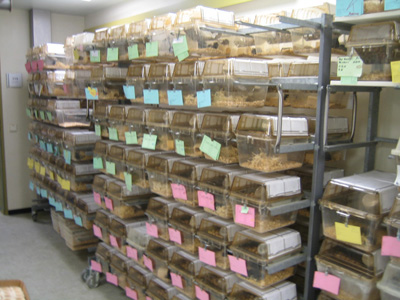Rodent Facility
Due to the similarity of rodent and human physiology, rodents are highly useful model systems with which to examine the potential relevance of biochemical or molecular biological findings for human physiology, pathology or toxicology. They are also the most widely used mammalian experimental models because they combine easy handling, maintenance and breeding with extensive possibilities for experimental manipulation.
 The rodent facility currently houses 8,000 mice and 1,000 rats from more than 130 strains. |
KIT has accommodated a modern Rodent Facility for the breeding and maintenance of mice and rats since 1993. It provides scientists with experimental animal models and a broad array of services. The facility currently houses over 8,000 mice, comprising more than 130 different mouse strains, and 1,000 rats. The Rodent Facility is unique due to the wide range of technologies that are currently employed, including administration of compounds, collection of blood samples, surgery (vasectomy, castration, partial hepatectomy, in vivo tissue transfection), cryo-conservation of mouse embryos, in vivo bioluminescence imaging, the creation of transgenic and knock out mouse lines and a central facility for histological analyses. Additionally, mice and rats in the facility are used as prime sources of genetically altered cells for in vitro experiments, such as neuronal, muscular and cancer stem cells.
Given the principal aims of the BIFTM programme, rodent models are vital for the validation in the intact organism of results obtained with cultured cells. Moreover, the evaluation of biofunctional surfaces depends crucially on rodents as a source of wild-type and genetically altered primary cells. Similarly, the assessment of in vivo effects of synthetic biomimetic tools (including their potential toxicity) requires experiments in rodents. A further major contribution of the Rodent Facility to the BIFTM Programme will be provided by the transgenic and knockout facility to test the role of identified genes in normal physiology and in pathological processes.
